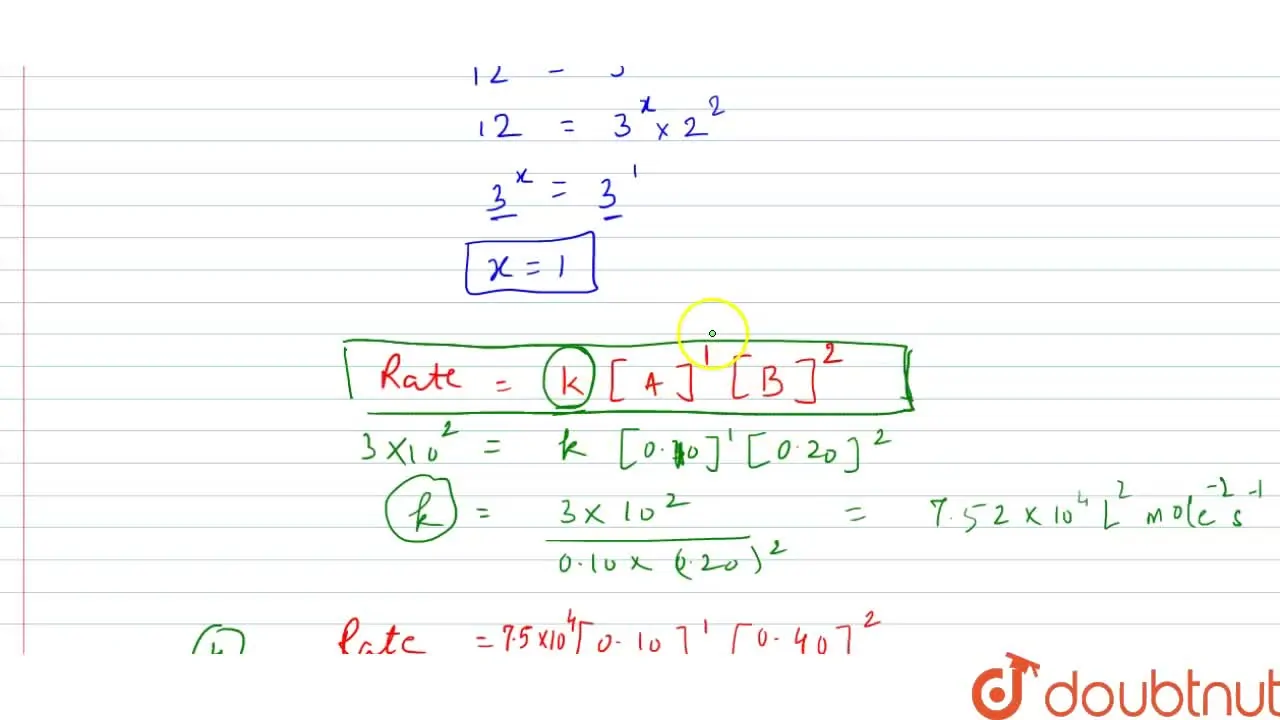For the hypothetical reaction
2A+B→ Products
following data obtained:
∣∣
∣
∣
∣
∣
∣
∣
∣
∣∣Experiment numberInitial conc of (A)(molL−1)Initial conc of (B)(molL−1)Initial rate molL−1s−110.100.203×10220.300.403.6×1010330.300.801.44×10440.100.40...50.200.60...60.301.20...∣∣
∣
∣
∣
∣
∣
∣
∣
∣∣
Find out how the rate of the reaction depends upon the concentration of A and B and fill in the blanks given in the table.
form experiments (2) and (3), it is clear that when the concentration of A is kept constant and that of B is doubled, the rate increases four times. This shows that the reaction is of second order with respect to B.
ismilarly, form experiments (1) and (2), it is observed that when the concentration of A is increased theee times and that of B two times, the rate becomes 12 times. Hence, the reaction is of first order with respect to A.
Thus, the rate law for the reaction is
Rate =k[A][B]2
Substituting the values of experiment (1) in the rate equation,
3×102=k[0.10][0.20]2
or k=3×102[0.10][0.20]2=7.5×104L2mol−2s−1
Experiment (4): Rate =k[0.10][0.40]2
=7.5×104×0.10×0.40×0.40
=1.2×103molL−1s−1
Experiment (5): Rate =k[0.20][0.60]2
=7.5×104×0.20×0.60×0.60
=5.4×103molL−1s−1
Experiment (6): Rate =k[0.30][1.20]2
=7.5×104×0.30×1.20×1.20
=3.24×104molL−1s−1
Related Playlists
- BOOK - CENGAGE CHEMISTRY ENGLISHCHAPTER - CHEMICAL KINETICSEXERCISE - Solved Example52videos
CHEMICAL KINETICS
- BOOK - CENGAGE CHEMISTRY ENGLISHCHAPTER - CHEMICAL KINETICSEXERCISE - Ex 4.1 (Objective)9videos
CHEMICAL KINETICS
- BOOK - CENGAGE CHEMISTRY ENGLISHCHAPTER - CARBOXYLIC ACIDS AND THEIR DERIVATIVESEXERCISE - Exercises Archives (Analytical And Descriptive)34videos
CARBOXYLIC ACIDS AND THEIR DERIVATIVES
- BOOK - CENGAGE CHEMISTRY ENGLISHCHAPTER - COORDINATION COMPOUNDSEXERCISE - Archives Subjective18videos
COORDINATION COMPOUNDS
Similar Questions
For a hypothetical reaction A+B→C, suggest the rate law and order form the following data:
∣∣ ∣ ∣ ∣ ∣∣Experiment[A](molL−1)[B](molL−1)Refer of reaction(molL−1s−1)I0.250.253.0×10−3II0.500.256.0×10−3III0.500.501.20×10−2∣∣ ∣ ∣ ∣ ∣∣View SolutionFor the reaction A+B→ products, what will be the order of reaction with respect to A and B?
Exp[A](molL−1)[B](molL−1)Initialrate(molL−1s−1)12.5×10−43×10−55×10−425×10−46×10−54×10−331×10−36×10−51.6×10−2View SolutionFor the given reaction ,
A+B→ Products
Following data are given :
initial conc.(m/L)initial conc.(m/L)initial conc.(mL−1S−1)[A]0[B]00.10.10.050.20.10.10.10.20.05
calculate the Rate constantView SolutionFind the values of A,B and C in the following table for the reaction X+Y→Z. The reaction is of first order w.r.t X and zero order w.r.t. Y.
Exp[X](molL−1)[Y](molL−1)Initialrate(molL−1s−1)10.10.12×10−22A0.24×10−230.40.4B4C0.22×10−2View SolutionFor the non-stoichiometric reaction 2A+B→C+D
The following kinetic data were obtained in theee separate experiment, all at 98K
∣∣ ∣ ∣ ∣ ∣∣Initial concentration (A)Initial concentration (B)Initial rate of formation of C(molL−1s−1)0.01M0.1M1.2×10−30.1M0.2M1.2×10−30.2M0.1M2.4×10−3∣∣ ∣ ∣ ∣ ∣∣
The rate law for the formation of C is:View SolutionRate of a reaction A+B→ Product, is given as a function of different initial concentration of A and B.
∣∣ ∣ ∣ ∣ ∣ ∣∣[A](molL−1)(B)(molL−1)Initial rate(molL−1−1min)0.010.010.0050.020.010.0100.010.020.005∣∣ ∣ ∣ ∣ ∣ ∣∣
Determine the order of the reaction with respect to A and with respect to B. What is the half life of A in the reaction ?View SolutionThe experiment data for the reaction 2A+B2→2AB is
∣∣ ∣ ∣ ∣ ∣∣Experiment[A]M[B2]MInitial rate(molL−1s−1)I0.500.51.6×10−4II0.501.03.2×10−4III1.001.03.2×10−4∣∣ ∣ ∣ ∣ ∣∣
Write the most probable rate equation for the reaction giving reason for your answer.View SolutionThe experiment data for the reaction 2A+B2→2AB is
∣∣ ∣ ∣ ∣ ∣∣Experiment[A]M[B2]MInitial rate(molL−1s−1)I0.500.51.6×10−4II0.501.03.2×10−4III1.001.03.2×10−4∣∣ ∣ ∣ ∣ ∣∣
Write the most probable rate equation for the reacting giving reason for you answer.View SolutionFor the reaction 2A+B→C, the values of initial rate at different reactant concentrations are given in the table below. The rate law for the reaction is : [A](molL−1)[B](molL−1)Initial Ratemol−1s−10.050.050.0450.100.050.0900.200.100.72
View SolutionDuring the kinetic study of the reaction, 2A+B→C+D , following results were obtained
Run[A]/molL−1[B]molL−1Initial rate formation of D/molL−1min−1I0.10.16.0×10−3II0.30.27.2×10−2III0.30.42.88×10−1IV0.40.12.40×10−2
Based on the above data which one of the following is correct ?View Solution


